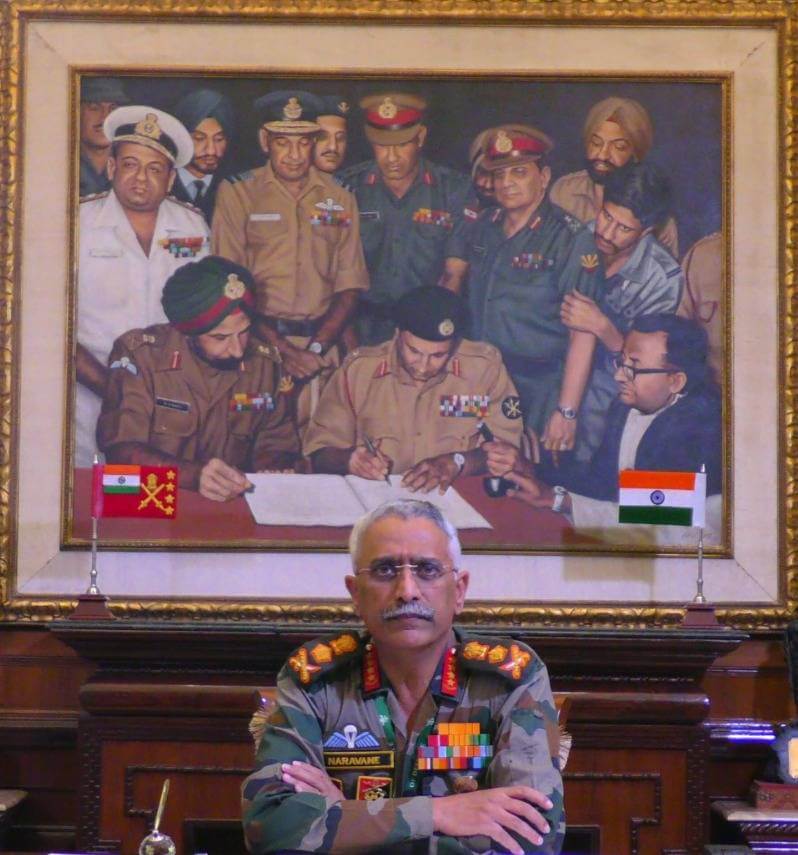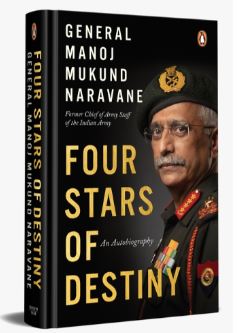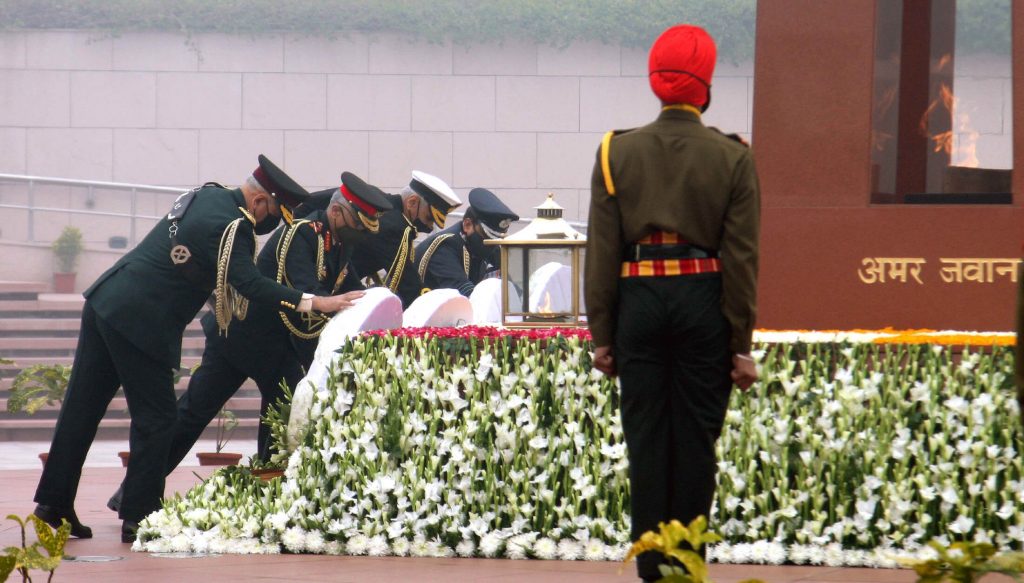
Former Indian Army Chief General MM Naravane’s memoirs titled ‘Four Stars of Destiny‘ is expected to be in the public domain sometime around April this year.

Never before in Indian Armed Forces history has a service Chief written his memoirs so soon after retirement. Gen Naravane superannuated from the armed forces on 30 April 2022, after completing a successful tenure of duty as the Indian Army Chief. Excerpts from his memoirs were posted in December 2023, and the book may be issued in April if the government permits.
Many people were astonished by the extracts since they highlighted some of the actions made by the government against the advice of military chiefs. Some skeptics speculated that the book would be prohibited, while sources indicated that the book will be evaluated by the Ministry of Defence. It was first surprised that the book was published without such a review. Even though there are no particular restrictions regarding retired officers’ publishing, prudence dictated that they be vetted by the appropriate authorities.
Recently, the Department of Personnel and Training amended the Central Civil Services (Pension) Rules, 1972, in June 2021, prohibiting retired government servants who served in intelligence or security-related organizations from publishing any information related to the organization after retirement without prior permission. The Army is now said to have launched a review of the book, which may eventually be cleared by the Ministry of Defence. Much of the material that might give deeper insights into decision making at the highest strategic level may be prone to deletion in this process with a ‘bureaucratic eye for detail.’ The analytical community would suffer as a result of this. In just under 20 months, General Naravane has managed to capture events from his term as Chief of the Army Staff, as well as other noteworthy episodes from his career that may still be fresh in the minds of many.
Excerpts from the book provide a bird’s eye view of some of the key events during General Naravane’s tenure as Chief of the Army Staff, including the start of the standoff on the Line of Actual Control [LAC] between the Indian Army and the People’s Liberation Army [PLA], which continues in at least two points to this day.
Three topics have sparked attention based on the snippets published. The first is the Indian Higher Command’s political and military response to developments on the Line of Actual Control [LAC] in Eastern Ladakh from May to August 2020, and the second is the Agnipath Scheme, which examines the pattern of induction and service conditions of soldiers in the Indian Armed Forces.
The Line of Actual Control (LAC) 2020

General Naravane discusses two significant events on the LAC, offering a bird’s-eye perspective of national command level meetings during the impasse with China in eastern Ladakh in mid-2020, as well as an insight into how India’s leadership continues to be given the lead in operational decisions to the Armed Forces brass. It is unclear if this is done to improve military accountability or merely as a matter of principle. The extracts include details on two LAC rulings.
Galwan Skirmish
On the Galwan incident on June 15/16, Gen Naravane says that Chinese President Xi Jinping will not forget June 16 anytime soon because China’s People’s Liberation Army sustained “fatal casualties” in the conflict for the first time in over two decades.
“(Chinese President) Xi Jinping’s birthday is June 16.” This is not a day he will soon forget. For the first time in more than two decades, the Chinese and the PLA had suffered fatalities,” says Gen Naravane. He goes on to say that the Galwan fight was “one of the saddest days” of his career. According to Gen Naravane, despite China’s acknowledgment that just five of its soldiers were killed in the conflict, it was clear that they “too suffered significantly.”
Gen Naravane writes, “Our men who were in Chinese hands had been kept out in the open and they had seen several bodies being fished out of the river. Whenever that happened, they were subjected to a fresh round of beatings”
“The ferocity with which they reacted was indicative of the losses they had suffered.” “At first, they refused to admit any casualties; then, many months later, they admitted to four or five killed, including the CO on their side,” he recalls. The fight appears to have happened when both parties disagreed on the retreat from PP 14 in the area where tents were built to establish the rights.
The Indian Army took the Kailash Range, a dominant mountain range in Eastern Ladakh south of the Pangong Tso lake, during the night of August 30/31. “On the Night of 29/30 August 2020, PLA troops violated the previous consensus reached during military and diplomatic engagements during the ongoing standoff in Eastern Ladakh and carried out provocative military movements to change the status quo,” said a Ministry of Defence press release on August 31. This PLA effort on the Southern Bank of Pangong Tso Lake was pre-empted by Indian forces, who took measures to reinforce our positions and resist Chinese aspirations to unilaterally change the facts on the ground.”
“The Indian Army is committed to maintaining peace and tranquility through dialogue, but is also equally determined to protect its territorial integrity,” ended the release.
Gen Naravane explains the inner workings at the highest levels that led to the takeover of the Kailash Range, which might have turned into a flashpoint if not managed appropriately. According to his account, the Chinese buildup was relayed to Defence Minister Rajnath Singh. On the night of August 31, he was informed by the Defence Minister, ‘Jo ucchit samjho woh karo’ (do whatever you think suitable), after a series of up and down exchanges, that the situation was “nearing breaking point.”
With the decision in the hands of the Army Chief, Naravane has clearly detailed what went into it and how he averted a massive confrontation of forces. “I was in my Army House lair, with a map of Jammu and Kashmir and Ladakh on one wall and the Eastern Command on the other. They were unlabeled maps, but I could see the position of every unit and formation as I looked at them. “We were prepared in every way, but did I really want to start a war?” he writes. “The country was in shambles, reeling from the Covid pandemic.” The economy was in trouble, and global supply systems had collapsed. Would we be able to maintain a regular supply of parts, etc., under these conditions, in the event of a protracted action? … Who were our worldwide backers, and what about the collusive menace posed by China and Pakistan? “A hundred different thoughts flashed through my mind,” according to the passages.
The Chief’s main inference was that being the first to start fire would “provide the Chinese with an excuse, a casus belli, to escalate and paint us as the aggressors.”
“Instead, I told him to move a troop of our tanks right to the forward slopes of the Pass and depress their guns so that the PLA would be staring down the barrels of our guns,” he wrote in his memoir. “This was done forthwith and the PLA tanks, which had by then reached within a few hundred metres of the top, stopped in their tracks.” “It didn’t take long for the PLA to respond. On the evening of the 30th, they advanced some soldiers in the Kailash Range region, halting approximately 500 meters short of our positions and dug in.”
Agnipath Scheme

According to Gen Naravane, the Agnipath project caught the Army off guard, while the Navy and Air Force were utterly unaware. The ‘Tour of Duty’ concept to induct troops for short-term service is said to have been proposed in early 2020.
According to media reports based on the passages, Naravane says in the book, “When I originally approached the Prime Minister about the Tour of Duty concept, it was more along the lines of a short-service option at the soldier level, akin to the Short Service Commission system for officers that was already in vogue…. Just as a limited number of SSC officers are recruited each year, a limited number of jawans would be similarly enrolled and released at the end of their “tour,” with the possibility of re-enlisting for another tour if proven fit.”
“We in the army were taken by surprise by this turn of events, but for the navy and air force, it came like a bolt from the blue,” the general wrote. According to the former Army Chief, he clarified to his Naval and Air Force counterparts that the plan was solely limited to the Army and entailed the retention of 75% of the recruited people, as opposed to the proposal adopted, which only kept 25%.
Also Read: Will ‘Tour of duty’ scheme– lead to financial savings?
Despite widespread mistrust among the military and veteran communities, the Agnipath Scheme has already been implemented in all three services, and the impact remains uncertain. There has been no explanation for the government’s decisions, which, according to Gen Naravane’s book, went against the Army Chief’s advice.
Having stimulated the readers’ appetite for more from the main actor during this period – the Army Chief – there would be a lot of interest in some of the critical decisions made in response to Chinese PLA advances on the LAC in April May 2020 to pull back from the Kailash Range, losing a dominant height in the critical ranges. With several main characters still in the chair, this might be a tempest in a teacup.

